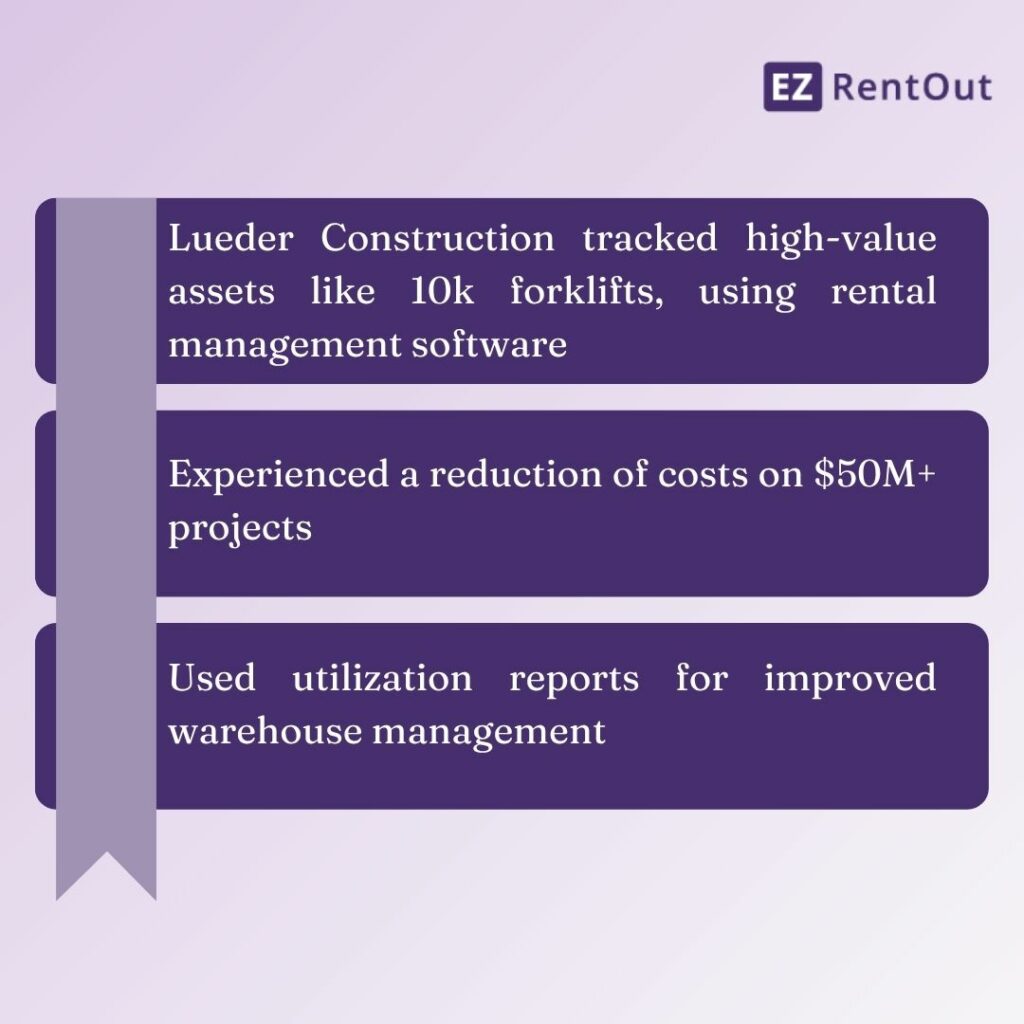A contractor places an order for an excavator, scheduled for delivery on Monday. Your team confirms the rental, but the machine is still out on a previous job, and no one has marked it as unavailable or returned. Monday comes, and there is no equipment and no backup plan. The contractor is furious because their project is delayed, and now your business is facing penalties, a damaged reputation, and the risk of losing future contracts.
Such an issue does not arise in conventional e-commerce businesses, where sold items are removed from inventory, making space for new stock. But rental inventory works differently. It refers to the consumable items a company owns and rents out repeatedly, which means that each item must be carefully tracked for availability, condition, maintenance status, and usage history.
In the case of the excavator, it was unaccounted for as there was no record of return or status update. That single gap in oversight resulted in project delays and reputational damage.
Optimized rental inventory management helps prevent such losses by streamlining bookings, enabling real-time tracking, and ensuring complete visibility into every asset’s lifecycle. In essence, managing your rental inventory effectively is the key to running a successful rental business and overcoming many of the challenges faced by rental businesses.
Manage rental inventory seamlessly
But what exactly makes rental inventory so challenging to manage? Let’s break it down.

Key challenges to managing rental inventory
Managing rental inventory involves more than just tracking when items are checked in or out. Without tight coordination across systems, teams, and timelines, even basic processes can break down, resulting in scheduling conflicts, lost equipment, or delayed deliveries. The following are some of the key challenges that stem specifically from poor rental inventory management.
1. Running out of stock
Fluctuating demand, seasonal peaks, and shifting customer preferences can make it challenging for rental businesses to accurately predict the quantity of each item they need in stock. For example, a surge in roadwork projects during the summer might drive up demand for compactors or excavators, while other items, such as generators, might sit idle. Without historical insight or real-time trend tracking, rental companies risk either overstocking low-demand equipment or running out of what is most needed.
This problem is made worse by poor visibility into item status. Equipment may appear available in the system even though it is still out on a job site, in transit, or under maintenance. For example, if a skid steer has not been checked back in properly after a weekend rental, it could accidentally be committed to another job – only for the team to realize too late that it is missing or unusable.
Infrequent maintenance tracking and aging assets further contribute to stock shortages. Items that are overdue for servicing may still be listed as rentable, leading to mid-project failures. And when older equipment is not rotated out on time, businesses unknowingly keep unreliable stock in circulation, which creates avoidable rental gaps and damages customer trust.
A clear example of this is Yellow Iron Rentals. Before switching to automated tracking, they faced frequent availability issues. Low-utilization equipment was occupying valuable space, while high-demand assets were often unavailable when needed. Without consistent maintenance tracking, some machines even exceeded safe usage limits, resulting in costly breakdowns and delayed rentals.
2. Overbookings and booking equipment that is already taken
Overbookings often occur when multiple teams or systems operate in silos, lacking a unified view of which equipment is reserved, returned, or still in use on a job. Without a centralized scheduling process, the same piece of equipment can end up being promised to more than one customer even if it is unavailable. These conflicts usually stem from manual tracking, unclear status updates, or delays in logging returns, especially during peak demand periods.
Lack of a consistent process for flagging unavailable equipment or setting buffer time between rentals further compounds the issue. This leads to missed commitments, disappointed customers, and a scramble for last-minute fixes.
3. Renting out items that are damaged or missing
When damaged equipment slips through without proper checks, it creates a chain of problems. Even minor wear and tear, if left unnoticed, can affect performance during the next rental, risking project delays or on-site accidents. This becomes particularly serious in industries like construction, where equipment is expected to function reliably under pressure.
Lost or missing items are equally disruptive when they remain listed as available in the system. Without clear usage logs or updated status tracking, teams may unknowingly promise equipment that does not exist, resulting in last-minute scrambles and customer frustration.
4. Deliveries that do not arrive on time
Coordinating deliveries and pickups becomes a major challenge when schedules are packed and resources are stretched. Poor route planning or a lack of available drivers can cause delays that ripple across multiple orders. These issues are often exacerbated by staff shortages or unexpected traffic conditions.
Manual systems also struggle to adapt to last-minute changes, like jobsite delays or urgent rescheduling. Without clear communication between teams and with the customer, updates can be missed or miscommunicated.
For instance, a delayed forklift drop-off at a construction site might halt an entire day’s progress.

5. Inventory reviews that miss the bigger picture
Routine inventory reviews, while essential, often fail to provide actionable insights. A list of items checked in or out does not always reveal deeper trends, like which assets sit idle for long periods or consistently return with issues. Without tying data to usage or revenue, underperforming equipment remains in rotation unnoticed.
The bigger issue is that reviews are often disconnected from broader business systems. Siloed data, fragmented spreadsheets, and manual logs limit visibility. Without context – like job type, rental frequency, or ROI – it becomes difficult to identify what needs to be replenished, retired, or redistributed.
6. Systems that do not work well together
When rental businesses rely on disconnected systems for bookings, maintenance, and billing, operational gaps become inevitable. Teams may log a return in one tool, but if it doesn’t sync with the dispatch system, that asset may still appear as available, leading to missed maintenance or overbookings.
This disconnect worsens when integrations with accounting or CRM tools, such as QuickBooks and Xero, are missing. Manual data transfers increase errors and slow down construction workflows.
For example, a construction equipment provider might mark an excavator as serviced in a maintenance app, but if the billing software is not updated, incorrect invoices or delays could follow.
7. Hard to predict what you will need next
Accurately forecasting demand is difficult when data is incomplete, scattered, or outdated. Many rental teams work with outdated spreadsheets or rely on incomplete usage data, making it difficult to identify emerging trends or plan stock levels effectively. Even when reports are available, they can be hard to interpret without the right tools or context.
These forecasting blind spots are compounded by unpredictable external factors, such as shifting project timelines or weather disruptions. Without real-time insights and forward-looking analysis, rental businesses can end up misallocating equipment and stocking too much of what is not needed and too little of what is.
Get Your Rental Inventory In Order
Best practices to optimize your rental inventory system
Now that we have broken down the key challenges of managing rental inventory, the question becomes: how do you stay ahead of them? The answer lies in building the following practices into your operations, which will ultimately improve visibility, strengthen asset control, and help you adapt as your business grows.
1. Focus on specific business needs
Not every rental item carries equal weight, as some are booked out constantly, while others sit idle for weeks, impacting asset utilization. A smart first step toward optimizing your rental inventory is to prioritize assets based on actual usage and demand trends.
Rental inventory management software built to optimize rental workflows supports this by letting you track booking frequency, rental duration, and utilization trends. With quick access to these insights – often visualized in reports or dashboards – you can make informed decisions on which items to stock, which to phase out, and how to allocate capital more effectively.
2. Organize your warehouse by inventory category
A cluttered warehouse layout can slow down order fulfillment, especially when multiple rentals are being processed at once. Grouping items into clearly labeled zones – based on type, size, or rental frequency – helps staff pick, dispatch, and return equipment faster, especially during high-volume periods.
One proven method is the ABC analysis, where high-value or frequently rented items (Class A) are placed in easily accessible zones, while less critical stock (Class B and C) can be stored further away.
With features like barcode scanning and mapped storage zones, rental software can further streamline this process by giving staff a clear picture of where everything is and ensuring fast, error-free retrieval during peak seasons.
3. Monitor the rental-to-inventory ratio
Tracking how frequently rental assets are booked versus how often they sit idle is critical for maximizing returns. When high-demand equipment is constantly unavailable, it signals a need for better stock planning, as underperforming assets consume valuable warehouse space. On the flip side, assets that are rarely rented can tie up capital, lead to cluttered storage, and inflate servicing costs without meaningful return.
A closer watch on rental-to-inventory ratios helps rental businesses decide whether to acquire more of certain equipment, retire aging or unused stock, or rebalance inventory based on seasonality or usage trends. Real-time rental tracking, return status updates, and utilization reports give operational clarity – especially when paired with availability calendars and automated alerts. These insights help prevent overlapping bookings and ensure enough of the right equipment is available at the right time.
For example, if a construction rental company sees that trench rollers are constantly booked while multiple ride-on trowels are collecting dust, this signals an imbalance in inventory investment, which could be easily corrected through regular ratio monitoring.
4. Use rental software for inventory cost valuations
Using a rental inventory management software that helps track asset costs over time is essential for keeping a clear financial picture of your rental inventory. You can test a rental inventory software, such as EZRentOut, by signing up for a free trial and assessing whether it fulfills your rental needs. With built-in dashboards and reporting tools, you can log purchase prices, monitor depreciation, and assess how long an asset has been in circulation. This establishes greater visibility, which is needed to make smarter decisions about when to retire, replace, or reinvest in equipment.
Furthermore, using inventory valuation methods such as FIFO (First-In, First-Out) or LIFO (Last-In, First-Out) helps provide a more accurate snapshot of asset value at any given time. Coupled with performance metrics such as rental frequency, these insights help identify underperforming or aging equipment, enabling more informed procurement decisions for construction rental equipment.
5. Utilize real-time data
You can also leverage real-time data derived from the rental inventory management system to operate more efficiently. This data enables teams to track equipment availability, location, and condition based on real-time developments – allowing staff to update asset status, record inspections, and report damage directly from the field. For example, if a jackhammer returns from a roadwork site with visible wear, a technician can instantly flag it for servicing, preventing future booking issues.

6. Automate inventory management
Automating parts of the rental workflow can significantly reduce delays and inconsistencies. For example, with rental software that supports asset tagging and lifecycle tracking, teams can stay updated on return statuses or maintenance schedules through rule-based triggers that respond to real-time asset status updates.
Such automation often incorporates features like barcode and QR scanning for faster check-ins, configurable alerts for overdue orders, and daily or instant email notifications for staff to track and be notified of key tasks. When paired with detailed asset records that capture rental history, service activity, and usage data, automation helps maintain consistency across workflows, ensuring that key actions such as bookings, inspections, and returns are properly recorded and followed through.
Lueder Construction is a strong example of the gains made possible through automated inventory management with rental software. By using EZRentOut, a leading rental asset management software, the company transformed manual overload into streamlined asset tracking, including high-value assets like skid loaders worth over half a million dollars. Automation enabled a structured differentiation between assets, asset stock, and inventory, ensuring smoother information flow, greater control over high-value equipment, and overall cost reduction on $50M+ projects.

7. Manage inventory across multiple locations
Managing inventory across multiple locations adds a layer of operational complications, especially when demand fluctuates from one site to another. Without centralized visibility, there are risks of shortages at high-demand sites and surplus stock sitting idle elsewhere, both of which tie up capital and impact efficiency.
Centralized tracking allows you to view real-time stock availability across sites and initiate transfers as needed. It also helps prevent duplicate bookings or misplaced items by maintaining a log of each asset’s current location, booking status, and assigned orders. This unified record makes it easier to track asset movement across sites and catch inconsistencies early.
For instance, relocating idle compactors from a quieter site to one receiving constant orders can help avoid rental losses.
8. Assess core business insights to forecast demand
Understanding how your rental inventory performs over time can reveal important insights about customer demand and asset efficiency. Analyzing key business metrics, such as asset utilization and turnover rates, helps anticipate which equipment is likely to be in demand and enables more proactive planning. This reduces the risk of last-minute shortages or idle inventory, especially during peak rental seasons.
Forecasting also improves when operational and financial data are considered together. For instance, having access to rental history, service records, and linked order details in one place can highlight usage patterns or reveal bottlenecks. These insights, supported by customizable inventory management KPIs like inventory days on hand, help rental businesses make more informed stocking decisions and plan ahead for seasonal or regional fluctuations.
9. Conduct regular inventory reviews
Regular inventory reviews or audits are essential for the maintenance of operational efficiency and the prevention of avoidable losses. These reviews involve carefully checking for inconsistencies, misplaced items, or discrepancies in records before they escalate into bigger issues. Scheduling quarterly or annual audits helps verify that tracked inventory matches what is actually available, ensuring the system reflects the ground reality.
Moreover, meaningful reviews shed light on how inventory is performing overall. Rental assets that show repeated use beyond optimal levels may require servicing or replacement, while consistently idle items may warrant reassessment of their place in the inventory. These insights support smarter decisions around asset lifecycle management and help ensure that every item continues to add value.
10. Analyze reports for decision-making
Detailed reporting helps rental businesses move beyond surface-level tracking and into deeper operational analysis. With the right software, companies can generate tailored custom reports and dashboards that highlight key metrics like asset utilization, maintenance history, booking frequency, and revenue per item. This visibility enables rental businesses to spot inefficiencies, track performance across locations, and further their understanding of what contributes to profit or loss.
Rental software with customizable reporting capabilities allows businesses to adapt insights to their specific needs, whether they deal in long-term construction rentals or short-term audiovisual equipment. Reports can be filtered by asset category, rental duration, or service activity, making it easier to decide when to retire aging assets, adjust procurement plans, or shift equipment where it is needed most. This data-backed decision-making supports smarter growth and more resilient inventory management.

From oversight to optimization of your rental inventory
Running a rental business requires the rigorous monitoring of equipment location, condition, and operational requirements to ensure timely availability for clients. Recalling the earlier scenario where an excavator went unaccounted for, leading to project delays and penalties, it is clear how a single lapse in inventory oversight ripples across operations. Once identified, the issue was addressed through structured return protocols and better coordination. As a result, future rentals of the same equipment were managed without disruption.
This is what strong rental inventory oversight looks like. By tracking assets accurately, reviewing trends, and acting on real-time data, rental businesses can avoid costly errors and operate with more confidence. A rental inventory management software helps bring all of this together – centralizing information, surfacing insights, and making it easier to scale operations without losing control.
Frequently Asked Questions
What exactly is rental inventory software?
Rental inventory software is a system that tracks which items are available, out for rent, location, condition, maintenance status, and billable usage so you always know what you own and what you can rent out.
How can rental inventory software help reduce errors from manual tracking?
It replaces spreadsheets with automated updates, photos, condition logs, location tracking and reminders. Less human error, fewer lost/misplaced items, better records.
What core features should I look for in rental inventory software?
Key features: item availability & scheduling, condition check-in/out, reservation/calendar view, location tracking, damage & image logs, maintenance tracking & usage reporting.
How do I choose a rental inventory system that scales with my business?
Choose software that supports multi-location, large numbers of assets, role based access, integrations with accounting or billing, and flexible licensing. EZRentOut is built for scaling rentals.
Can I use rental inventory software for both small and large fleets?
Yes. Many tools offer tiered plans. For small fleets, you prioritize ease & cost; for large ones, you need strong reporting, automation, and field/mobile access.
How much does rental inventory software usually cost?
Costs vary: subscription plans (per asset/item, per location, or per user), setup/onboarding, integrations. Budget vs premium versions differ based on depth of features (e.g. usage, maintenance, etc.).
Is rental inventory software helpful for tracking equipment condition and damage?
Yes. Many systems allow you to upload photos, tag damage, note wear, record check-in/out condition. That helps with maintenance, insurance, and customer disputes.
How does scheduling/reservations work in rental inventory software?
The software typically shows a calendar or timeline view; you can reserve items ahead, block out maintenance periods, see conflicts, and ensure you don’t double book.
What reporting capabilities should I expect?
Reports on utilization (how often each item is rented), idle time, revenue per item, maintenance costs, availability, turnover, and location performance.
How important is mobile/field access for rental inventory management?
Very important: field staff need to update item condition, location, status in real time. Mobile apps speed up check-outs/check-ins and reduce lag in record updates.
Can rental inventory software integrate with accounting/billing systems?
Yes. Integration helps sync rental charges, deposits, invoices; reduce manual reconciliation. Tools like EZRentOut support many integrations.
How do I prevent loss or theft of items using software?
Use asset tagging/barcodes/RFID, require check-in/out workflows with accountability, track GPS/location if possible, log when items are expected back, set alerts for overdue returns.
What challenges do people usually face when implementing rental inventory software?
Challenges include migrating existing data (inventory, condition, history), staff training, changing workflows, ensuring consistent usage of the system, handling offline or field areas with no connectivity.
How fast can I see ROI from using rental inventory software?
Often within a few months: from fewer lost items, better utilization (less idle stock), fewer maintenance surprises, faster fulfillment. Savings from reduced manual work are immediate.
Will rental inventory software handle multiple locations or warehouses?
If built for scale, yes. It should allow you to set locations, track stock per location, move inventory between locations, and see availability across all sites.
What are “utilization” metrics, and why do they matter?
Utilization metrics tell how often an item is rented vs idle. High utilization means better revenue and return on investment; low utilization signals over-stock or wrong inventory mix.
How do I choose between cloud-based vs on-premises rental inventory software?
Cloud gives ease of access, lower infrastructure cost, automatic updates; on-premises might offer more control/privacy but higher maintenance & setup cost.
How can the software help with cleaning, inspection, maintenance before/after rentals?
It can trigger tasks on return (inspection, cleaning), schedule preventive maintenance, track parts needed, log work order history, set reminders for condition checks.
What is the role of customer & usage tracking in inventory software?
Tracking who rented what, how long, and condition helps with accountability, billing (overage, damage), maintenance planning, and understanding product demand.
How does EZRentOut compare with generic rental inventory solutions?
EZRentOut offers tailored features: calendar & scheduling, condition tracking, location visibility, maintenance workflows, integrations, and scalable licensing—so you get a full-featured system designed for rental businesses.
Was this helpful?
- Key challenges to managing rental inventory
- 1. Running out of stock
- 2. Overbookings and booking equipment that is already taken
- 3. Renting out items that are damaged or missing
- 4. Deliveries that do not arrive on time
- 5. Inventory reviews that miss the bigger picture
- 6. Systems that do not work well together
- 7. Hard to predict what you will need next
- Best practices to optimize your rental inventory system
- 1. Focus on specific business needs
- 2. Organize your warehouse by inventory category
- 3. Monitor the rental-to-inventory ratio
- 4. Use rental software for inventory cost valuations
- 5. Utilize real-time data
- 6. Automate inventory management
- 7. Manage inventory across multiple locations
- 8. Assess core business insights to forecast demand
- 9. Conduct regular inventory reviews
- 10. Analyze reports for decision-making
- From oversight to optimization of your rental inventory
- Frequently Asked Questions
- What exactly is rental inventory software?
- How can rental inventory software help reduce errors from manual tracking?
- What core features should I look for in rental inventory software?
- How do I choose a rental inventory system that scales with my business?
- Can I use rental inventory software for both small and large fleets?
- How much does rental inventory software usually cost?
- Is rental inventory software helpful for tracking equipment condition and damage?
- How does scheduling/reservations work in rental inventory software?
- What reporting capabilities should I expect?
- How important is mobile/field access for rental inventory management?
- Can rental inventory software integrate with accounting/billing systems?
- How do I prevent loss or theft of items using software?
- What challenges do people usually face when implementing rental inventory software?
- How fast can I see ROI from using rental inventory software?
- Will rental inventory software handle multiple locations or warehouses?
- What are “utilization” metrics, and why do they matter?
- How do I choose between cloud-based vs on-premises rental inventory software?
- How can the software help with cleaning, inspection, maintenance before/after rentals?
- What is the role of customer & usage tracking in inventory software?
- How does EZRentOut compare with generic rental inventory solutions?










